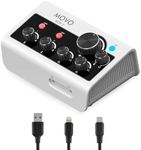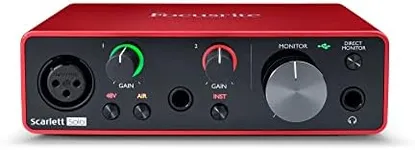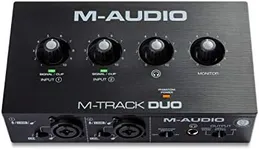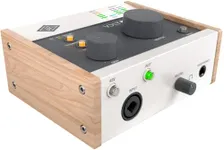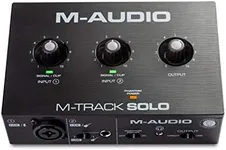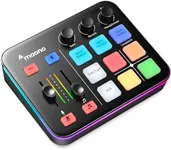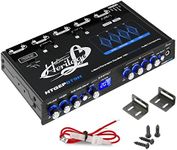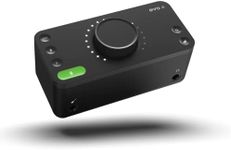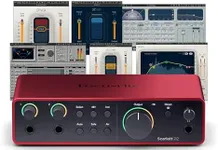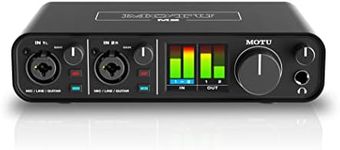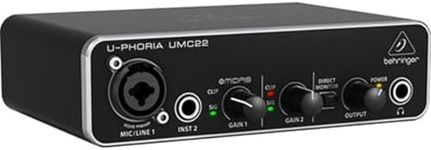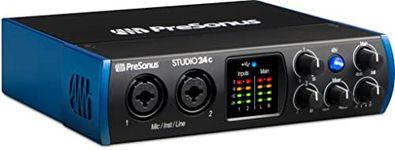We Use CookiesWe use cookies to enhance the security, performance,
functionality and for analytical and promotional activities. By continuing to browse this site you
are agreeing to our privacy policy
10 Best Audio Interfaces 2025 in the United States
From leading brands and best sellers available on the web.How do we rank products for you?
Our technology thoroughly searches through the online shopping world, reviewing hundreds of sites. We then process and analyze this information, updating in real-time to bring you the latest top-rated products. This way, you always get the best and most current options available.

Most Popular Categories Right Now
FAQ
Buying Guide for the Best Audio Interfaces
Choosing the right audio interface is crucial for anyone involved in music production, podcasting, or any form of audio recording. An audio interface is a device that connects your instruments, microphones, and other audio gear to your computer, converting analog signals into digital data that your computer can process. To find the best fit for your needs, you should consider several key specifications. Understanding these specs will help you make an informed decision and ensure that your audio interface meets your specific requirements.Number of Inputs and OutputsThe number of inputs and outputs on an audio interface determines how many devices you can connect simultaneously. Inputs are used for connecting microphones, instruments, and other audio sources, while outputs are for connecting speakers, headphones, and other monitoring equipment. If you are a solo musician or podcaster, a 2-in/2-out interface might be sufficient. However, if you plan to record a band or multiple sources at once, you may need an interface with more inputs and outputs, such as 8-in/8-out or higher. Consider your current and future needs when deciding on the number of inputs and outputs.
Audio Quality (Bit Depth and Sample Rate)Audio quality is determined by the bit depth and sample rate of the audio interface. Bit depth affects the dynamic range of your recordings, with higher bit depths providing more detail and less noise. Common bit depths are 16-bit, 24-bit, and 32-bit. Sample rate refers to how many times per second the audio is sampled, with higher sample rates capturing more detail. Common sample rates are 44.1kHz, 48kHz, 96kHz, and 192kHz. For most home studios, a 24-bit/48kHz interface is sufficient, but if you require the highest quality recordings, consider an interface with higher bit depth and sample rate.
ConnectivityThe type of connectivity an audio interface offers determines how it connects to your computer. Common connection types include USB, Thunderbolt, and FireWire. USB interfaces are widely compatible and suitable for most users. Thunderbolt interfaces offer faster data transfer rates and lower latency, making them ideal for professional studios and users with high-performance needs. FireWire is less common but still used in some professional settings. Choose an interface with a connection type that is compatible with your computer and meets your performance requirements.
Phantom PowerPhantom power is a feature that supplies power to condenser microphones, which require an external power source to operate. If you plan to use condenser microphones, ensure that your audio interface has phantom power (usually +48V). This feature is essential for capturing high-quality vocal and instrument recordings. If you only use dynamic microphones, which do not require phantom power, this feature may not be as important.
LatencyLatency refers to the delay between the input signal (e.g., your voice or instrument) and the output signal (e.g., what you hear in your headphones). Low latency is crucial for real-time monitoring and recording, as high latency can be distracting and make it difficult to perform. Look for an audio interface with low-latency drivers and direct monitoring features to minimize delay. If you are a musician or podcaster who needs to monitor your recordings in real-time, prioritize interfaces with low latency.
Preamp QualityPreamps amplify the signal from your microphones and instruments before it is converted to digital data. The quality of the preamps in an audio interface can significantly impact the clarity and warmth of your recordings. High-quality preamps provide clean, transparent amplification with minimal noise. If you are recording vocals or acoustic instruments, prioritize interfaces with high-quality preamps. For basic recording needs, standard preamps may suffice, but for professional-quality recordings, invest in an interface with superior preamp quality.
Build Quality and PortabilityThe build quality and portability of an audio interface are important considerations, especially if you plan to use it in different locations or on the go. A robust, well-built interface will withstand the rigors of travel and frequent use. If you need a portable solution, look for a compact and lightweight interface that is easy to transport. For a stationary setup, build quality is still important, but portability may be less of a concern. Consider your usage scenario and choose an interface that matches your durability and portability needs.
Software and CompatibilityMany audio interfaces come with bundled software, such as digital audio workstations (DAWs), plugins, and virtual instruments. This software can add significant value and enhance your recording capabilities. Ensure that the interface is compatible with your preferred DAW and operating system (Windows, macOS, etc.). Check for driver support and updates from the manufacturer to ensure smooth operation. If you are new to recording, bundled software can provide a great starting point, while experienced users may prioritize compatibility with their existing setup.
